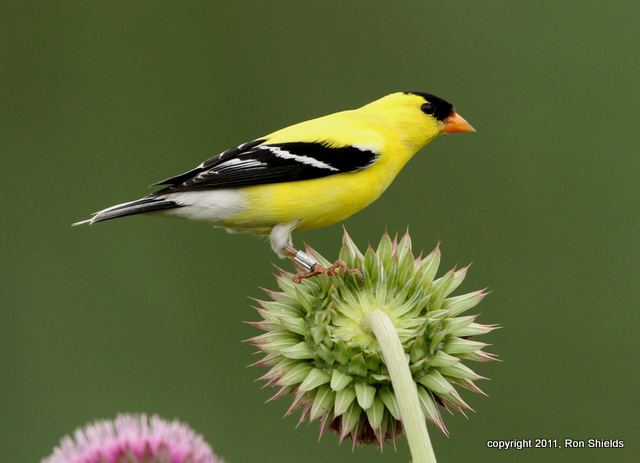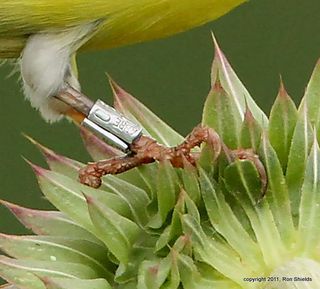 Ron Shields took this photo of New Jersey's state bird earlier this week by
Ron Shields took this photo of New Jersey's state bird earlier this week by  the Carillon Disposal Road and, lo and behold, it was banded.
the Carillon Disposal Road and, lo and behold, it was banded.
We figured it was one of the birds that NJMC Naturalist Mike Newhouse and his crew banded by the nearby Erie Landfill, but we figured wrong.
All we can make out on the band are the letters "ABRE." We are trying to discern what that stands for.
Anybody help out? (Thanks, Ron!)

Abre means “open” in Spanish.
I submitted this band info to the Patuxent Wildlife Research Center Bird Banding Laboratory. Maybe we’ll hear back.
ABRE is on all bird bands, so it may still be one of NJMC’s
a bird banded with an aluminum, official government (Bird Banding numbers.
The band number on size 1A and other small size bands is flanked vertically by the words “OPEN” and “ABRE”, which is Spanish for open. The hope is that one who finds a dead banded bird will open the band, discover the 1-800-327-BAND number inside and call in the find. The 1-800 number works from the US, Canada, and Mexico and has greatly increased band reports over the past decade.
Nine digits and two words constitute a lot of information to be stamped on the outside of a small bird band. That, the complex arrangement of the information, and some distortion inherent in the production of aluminum bands, can make them hard to read, even in hand. Thus, it is common for numbers on small aluminum bands to be misread. It is common enough that the Bird Band Laboratory uses a form letter to reply to persons reporting incomplete band numbers.
Even at the Bird Banding Laboratory there is not a specific registry for Purple Martins banded with the official aluminum bands, but the Lab has all records of Purple Martins banded and reported by the banders. The records essentially are in a huge database with records of all other species. Data for an individual band number, as well as batches of data, say for all Purple Martins banded in a state, can be extracted readily.
The Lab also maintains a database of banders’ color-marking authorizations. Thus, if one can’t read all of the digits of an aluminum band on a Purple Martin, but can accurately read a color band, say red with white letters and numbers A123, the Lab can usually determine who the bander was, and that bander should know exactly which bird was observed.
The system works well enough for most purposes, but it is about to get better. The Bird Banding Lab is close to finishing an overhaul and modernization of its massive records processing system. The new system will make it easier to link color band codes with aluminum band numbers on specific birds.
For more information on bird bands, see http://www.pwrc.usgs.gov/BBL/homepage/btypes.htm
To report a banded, or otherwise marked, bird, see http://www.pwrc.usgs.gov/BBL/homepage/call800.htm
Thank you Chuck, and all others with an interest in reporting Purple Martin bands.
John Tautin, PMCA
_________________
John Tautin, Executive Director, PMCA
Thanks for the feedback!
Much appreciated.
I have a band with 22 11 on the top line, and 203 40 on line two. What does that tell me?
John, Check out the comments below for more info, What species are you talking about?